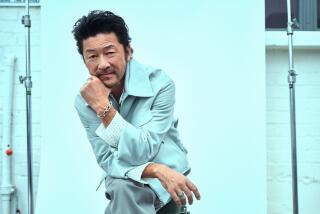A Director’s Tribute to His Late Colleagues
- Share via
TOKYO — Thirty years ago, Akira Kurosawa and three other masters of Japanese film began a project to jointly write and direct a samurai movie.
Their “Committee of Four Knights” got bogged down by artistic disagreements and other problems, leaving the film unfinished--and, it seemed, forgotten.
But in memory of his three late colleagues, Kon Ichikawa, 84, has resurrected the film. “Dora-Heita,” shown at this year’s Berlin Film Festival and opening in Japan this month, is Ichikawa’s most ambitious work in years.
Dedicated to Kurosawa, Keisuke Kinoshita and Masaki Kobayashi, it is made in the carefully shot, cleverly scripted tradition that won international acclaim for Japanese films in their glory days decades ago.
“We made fantastic movies back then,” Ichikawa said. “We could go up against the best.”
The film tells the story of a cocky warrior named Dora-Heita, who infiltrates the lowlife of a crime-infested town to battle corruption. It’s fast-moving, slick entertainment, with finely choreographed sword fights.
In one scene, Dora-Heita knocks out 50 swordsmen in a row, though he leaves them unscathed by the blade of his sword in accordance with the idealized samurai etiquette for law-enforcement officials of those times.
The camera work, which uses a strobe-light effect, transforms violence into a dreamlike sequence--a ballet-like flurry of kimono sleeves and flashing metal.
“The sword fight is a great film aesthetic that our predecessors created,” Ichikawa said in a recent interview in Tokyo, his trademark knit cap on his head and a smoky Camel dangling from his lips.
“Dora-Heita” is a testament to a legacy that includes Kurosawa’s “Rashomon,” “Seven Samurai” and “Kagemusha.” Japan’s younger generation of directors--Takeshi Kitano, Nagisa Oshima and the late Juzo Itami--have continued the tradition.
Although known less abroad, Kinoshita and Kobayashi are highly respected directors in Japan. Kinoshita, who died in 1998, is best-known for his antiwar film “Twenty-Four Eyes,” which depicts the bond between a teacher and her students.
Kobayashi’s “Harakiri,” which criticized social hypocrisy, and “Kwaidan,” a collection of traditional ghost stories, won rave reviews abroad. Kobayashi also directed the epic documentary “Tokyo Trial.” He died in 1996.
Kurosawa, who died two years ago, was a friend of Ichikawa. They made a point of visiting each other’s sets for at least a day when either was shooting a film. “It was actually more of a nuisance when he visited,” Ichikawa recalled, laughing.
Ichikawa has directed 74 films. Among them: the sultry yet delicate “The Makioka Sisters,” based on the story by Junichiro Tanizaki, and “Harp of Burma,” about a guilt-filled Japanese soldier who becomes a wandering monk. Ichikawa made “Harp of Burma” twice, in 1956 and 1985.
He is especially proud of his 1965 “Tokyo Olympiad,” a stark, pioneering work about the Tokyo Olympic Games that stirred up controversy for mixing fine art with documentary.
More recently, he has made less serious, campy horror-mysteries, including “The Eight Tomb Village” in 1996, that have won a strong following at home. Earlier this year, he made “Shinsengumi,” another samurai period piece.
*
Ichikawa still has more than a dozen ideas for films and vows he will never stop making movies.
“I believe this is what God intended me to do. And I love it,” he said. “Spiritually, nothing has changed for me from my first film.”
He adds: “I don’t see myself as a master. I’m just a kid who loves movies.”
As with most Ichikawa works, “Dora-Heita” is surprisingly modern--even fashionably youthful--and shows parallels with recent mysteries out of Hollywood like “Seven” and “L.A. Confidential,” both works that Ichikawa praises.
Still, the director is critical of the recent emphasis on high-tech special effects.
“The last American movie that truly moved me was Arthur Penn’s ‘Bonnie and Clyde,’ ” he said. “The essence of films is eternal. It’s about looking at life and people through that square window.”
More to Read
Only good movies
Get the Indie Focus newsletter, Mark Olsen's weekly guide to the world of cinema.
You may occasionally receive promotional content from the Los Angeles Times.










